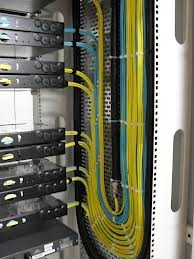Structured Cabling Systems
 Structured cabling
systems consist of cabling and other connectivity products that
integrate data, video, voice and building management systems within a
building. They include security access, safety alarms and energy systems
among others.
Structured cabling
systems consist of cabling and other connectivity products that
integrate data, video, voice and building management systems within a
building. They include security access, safety alarms and energy systems
among others.Data and voice systems used to be cabled separately but the current standard practice is to integrate them into a single system. Such integration and the use of internationally standardized methods lower the initial cost of cabling by as much as 30 percent. Of course, the actual savings will depend on configurations used and cost of materials and labor.
Careful Planning of Structured Cabling
Although it is possible to use the same type of cable in a structured cabling system to deliver all power-limited services, it is important to use the best method of integrating the systems. There is need for careful early planning to choose the right cabling system that will be compatible with all systems to be integrated.Industry standards for data and voice systems have been created by a number of bodies, including the International Standards Organization (ISO) and Electronic Industries Association (EIA). The standards address cabling and methods of delivering the cables. Prior to the establishment of the standards, people used many types of cables and different methods of wiring, which made it almost impossible to manage data networks. Changing systems often led to new cabling requirements because of lack of flexibility.
Decision makers can choose different methods. A standardized cabling architecture may incorporate horizontal electrical services. Alternatively, only the delivery methods may be consolidated into a single cable-tray system. Early planning will help in selecting the right types of cable irrespective of the method chosen.
Advantages of Structured Cabling Systems
Integrating different systems into a single unit provides several benefits:- Reducing multiple spaces required for separate installations
- Easy maintenance since all systems will be in the same area
- Flexibility that makes it easy to upgrade or change systems
- Reducing cost of installation
- Long life - Structured cabling is an investment that will last for the long term.
- Support for multi-vendor equipment - A standards-based structured cabling system will support your applications and hardware even after you change or mix & match vendors.
- Simplify troubleshooting - Even cables that were installed correctly can fail -- and they do. With a structured wiring system, problems are less likely to down the entire network, easier to isolate, and easier to fix.
The open-office cabling system or pre-wired zone cabling makes it possible to provide cabling designs even when it is still not clear where devices will be placed. The design will strive to make the best use of the type and size of space.
It is relatively easier to install cabling during the construction stage, and the method does not interfere with finished surfaces. With proper design, the cabling can be re-used throughout the life of the building. Re-wiring does not only lead to cluttered spaces but also affect the physical structure of a building because of necessary modifications.



No comments:
Post a Comment